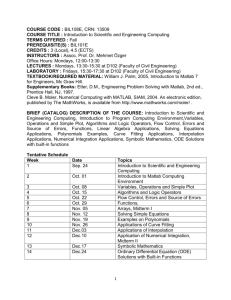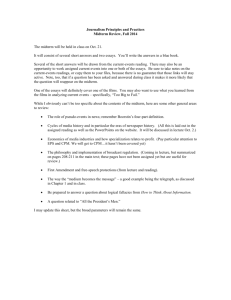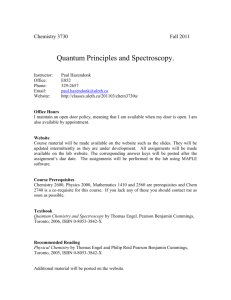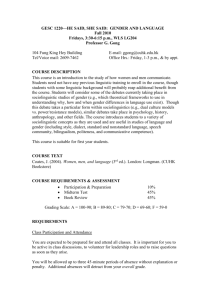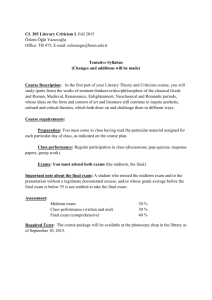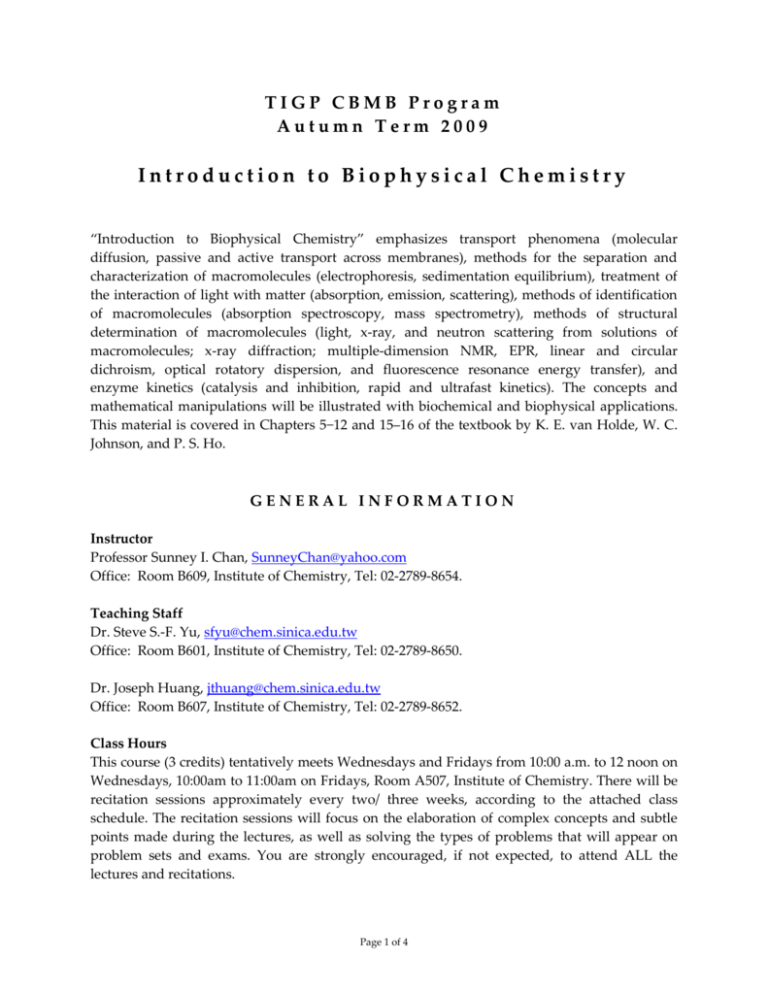
TIGP CBMB Program
Autumn Term 2009
Introduction to Biophysical Chemistry
“Introduction to Biophysical Chemistry” emphasizes transport phenomena (molecular
diffusion, passive and active transport across membranes), methods for the separation and
characterization of macromolecules (electrophoresis, sedimentation equilibrium), treatment of
the interaction of light with matter (absorption, emission, scattering), methods of identification
of macromolecules (absorption spectroscopy, mass spectrometry), methods of structural
determination of macromolecules (light, x-ray, and neutron scattering from solutions of
macromolecules; x-ray diffraction; multiple-dimension NMR, EPR, linear and circular
dichroism, optical rotatory dispersion, and fluorescence resonance energy transfer), and
enzyme kinetics (catalysis and inhibition, rapid and ultrafast kinetics). The concepts and
mathematical manipulations will be illustrated with biochemical and biophysical applications.
This material is covered in Chapters 5−12 and 15–16 of the textbook by K. E. van Holde, W. C.
Johnson, and P. S. Ho.
GENERAL INFORMATION
Instructor
Professor Sunney I. Chan, SunneyChan@yahoo.com
Office: Room B609, Institute of Chemistry, Tel: 02-2789-8654.
Teaching Staff
Dr. Steve S.-F. Yu, sfyu@chem.sinica.edu.tw
Office: Room B601, Institute of Chemistry, Tel: 02-2789-8650.
Dr. Joseph Huang, jthuang@chem.sinica.edu.tw
Office: Room B607, Institute of Chemistry, Tel: 02-2789-8652.
Class Hours
This course (3 credits) tentatively meets Wednesdays and Fridays from 10:00 a.m. to 12 noon on
Wednesdays, 10:00am to 11:00am on Fridays, Room A507, Institute of Chemistry. There will be
recitation sessions approximately every two/ three weeks, according to the attached class
schedule. The recitation sessions will focus on the elaboration of complex concepts and subtle
points made during the lectures, as well as solving the types of problems that will appear on
problem sets and exams. You are strongly encouraged, if not expected, to attend ALL the
lectures and recitations.
Page 1 of 4
Texts
Required: Kensal E. van Holde, W. Curtis Johnson, and Pui Shing Ho, “Principles of Physical
Biochemistry” (Second Edition 2006), Pearson Prentice Hall, Upper Saddle River, New Jersey.
Suggested: David Eisenberg and Donald Crothers, “Physical Chemistry with Applications to the
Life Sciences”, Benjamin Cummings Publishing Company, Inc., 1979.
Grading
There will be a midterm and a final examination. Your grade is based on: homework (40%),
midterm (30%), and final (30%). To encourage class and recitation participation (attendance,
questions, comments, etc.), a bonus of up to 10% will be added to your final grade based on
your participation, prorated according to your actual attendance. A problem set will be due
approximately every two weeks. If you fail to obtain a copy of a homework set when it is
handed out in class, you may download it from the course website. The midterm and final
exams will not be found on the course website.
Completed assignments and midterm exams should be handed in during class hours, unless
alternative arrangements are made with Dr. Steve Yu. Graded homework and exam papers will
also be returned in class. Outside of class hours, you may pick up graded assignments from
Joseph Huang. Please staple all work.
Web Site
Handouts, problem sets, answer keys, lecture notes and other useful material for this course
may be found at: http://idv.sinica.edu.tw/sfyu/BiophysChem
Problem Sets
Homework will be handed out during class/recitation on a Friday (see schedule) and usually
due 12 days later on Wednesday by 10:00 a.m. Solutions will be given out by Friday of the same
week. Late assignments will be accepted, with the following penalties for a 100-point
assignment:
30% if turned in by Thursday 10:00 a.m. following the Wednesday due date;
50% if turned in by Friday 10:00 a.m. following the Wednesday due date;
70% if turned in by Monday 10:00 a.m. the following week;
90% if turned in by Tuesday 10:00 a.m. the week later;
100% if turned in after Wednesday 10:00 a.m. of the second week.
All homework must be turned in. Failure to do so will result in a grade of “F” or “I”.
Page 2 of 4
CLASS SCHEDULE
HO = Homework handed out, HD = Homework due, MT = Midterm
W
Sep 16
Organization. Molecular diffusion.
Passive transport across membranes.
W
F
Sep 18
Transporters and ion channels.
F
W
Sep 23
Diffusion coefficients and frictional
coefficients. Gel electrophoresis.
F
Sep 25
Sedimentation. (HO-1).
W
Nov 25
W
Sep 30
Random Walk. Measurements of
diffusion coefficients
F
Nov 27
F
Oct 2
Recitation 1.
W
Dec 2
W
Oct 7
Rates and mechanisms of chemical
reactions. Temperature dependence
of rate constants. (HD-1).
F
Dec 4
F
Oct 9
W
Oct 14
F
Oct 16
W
Oct 21
F
Oct 23
W
Oct 28
F
Oct 30
W/F
Nov
4/6
Enzyme kinetics.
W/F
Nov 11
Nov
13
Nov
18/20
W
Dec 9
Methods of rapid and ultra-fast
kinetics. I
Methods of rapid and ultra-fast
kinetics. II (HO-2). .
Kinetics of protein folding and
unfolding.
F
Dec 11
W
Dec 16
F
Dec 18
Recitation 2.
W
Dec 23
F
Dec 25
W
Dec 30
M/F
Jan 4-8
Introduction to spectroscopy.
Interaction of light with matter.
Classical description of absorption
and dispersion. (HD-2).
Interaction of light with matter.
Classical versus quantum description.
Midterm week. (MT due Nov 6).
Elements of quantum mechanics.
Principles of chemical bonding.
Selection rules. Electronic spectroscopy of biological chromophores.
No class.
IR and Raman spectroscopy. Total
attenuated FTIR.
Spontaneous emission of light.
Fluorescence and phosphorrescence. (HO-3).
Fluorescence resonance energy
transfer (FRET).
Recitation 3.
Spectroscopy of interacting
chromophores. Exciton interaction.
Hypo- and hyper-chroism. (HD3).
Polarized light. Circular dichroism
and optical rotatory dispersion.
Electron spin and paramagnetic
resonance. Spin labeling.
Nuclear magnetic resonance.
Nuclear spin relaxation. (HO-4).
Multi-dimensional NMR in
solution. Protein structural
determination in solution.
Recitation 4.
Modern mass spectroscopy.
Single-molecule methods. (HD-4).
Final week. (Final due 4 p.m. Jan
8th.
(23 lectures, 4 recitations, 4 problem sets, 1 midterm, 1 final)
Page 3 of 4
Reading Assignments
Kensal E. van Holde, W. Curtis Johnson, and Pui Shing Ho, “Principles of Physical
Biochemistry” (Second Edition 2006), Pearson Prentice Hall, Upper Saddle River, New Jersey
07458
Chapter 5.
Methods for the separation and characterization of macromolecules
Chapter 6.
X-ray diffraction
Chapter 7.
Scattering from solution of macromolecules
Chapter 8.
Quantum mechanics and spectroscopy
Chapter 9.
Absorption spectroscopy
Chapter 10.
Linear and circular dichroism
Chapter 11.
Emission spectroscopy.
Chapter 12.
Nuclear magnetic resonance
Chapter 15.
Mass spectrometry of macromolecules
Chapter 16.
Single-molecule methods
Page 4 of 4


